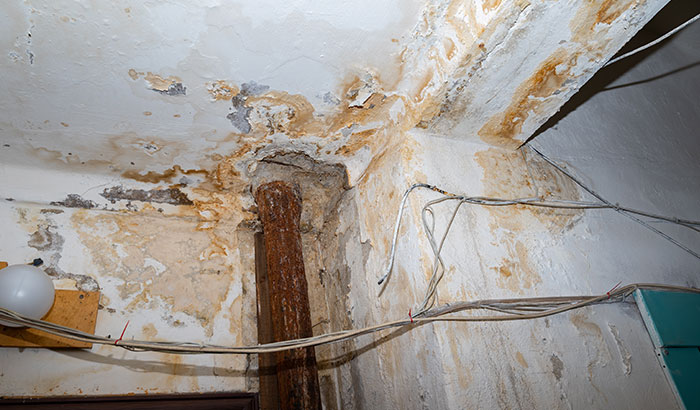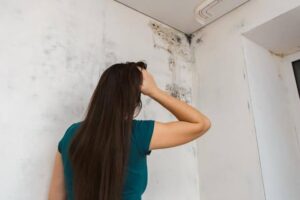If you have moldy drywall and are looking for suggestions on what to do for moldy drywall removal, this article has all the information you seek. Continue reading, and you’ll find out exactly what to look for, why you have mold, how to fix the problem, and how to prevent future growth.
Let’s get started.
How does mold get into your drywall?
Mold can grow on drywall if the drywall becomes wet or damp from leaks, high humidity, or flooding. If water is not promptly removed from the drywall and the area is not adequately dried, mold can begin to grow.
Additionally, mold spores can be present in the air and may settle on the wet drywall, leading to mold growth. Therefore, it is important to check for water leaks, dry out any wet areas immediately, and use dehumidifiers in high-humidity areas.
What Does Drywall With Mold Look Like?
Mold on drywall typically appears as discoloration, ranging in color to black, green, white, and brown hues. The discoloration may appear as small spots or large areas and have a fuzzy or slimy texture. The mold may also have a musty or damp smell. In some cases, the drywall may become soft and spongy to the touch if it has been significantly affected by mold.
If you suspect you have mold, it is recommended that you consult a professional to test and identify the mold before undertaking any remediation efforts.
Mold Exposure — How Will It Affect Your Health?
Mold growing in your drywall can have negative effects on your health. Mold exposure can lead to mold poisoning and cause various symptoms, which will depend on the individual and the type of mold they are exposed to. Some common symptoms of mold exposure include:
- Allergic Reactions – Symptoms such as sneezing, runny nose, red eyes, and skin rash can occur in people who are allergic to mold.
- Respiratory Issues – Mold exposure can cause symptoms such as nasal stuffiness and congestion, throat irritation, coughing, and wheezing. Some people may experience a fever or shortness of breath.
- Eye Irritation – Mold can cause redness, itching, and watering of the eyes.
- Skin Irritation – Mold can cause some people a rash or skin irritation.
- Asthma and Other Respiratory Conditions – Mold exposure can exacerbate existing respiratory conditions, such as asthma, making symptoms worse.
- Compromised Immune System – Young children and elderly individuals may be at a greater risk of developing health issues related to mold exposure.
What Are the Symptoms of Mold Exposure?
Mold exposure can cause a variety of symptoms, which can vary depending on the individual and the type of mold they are exposed to. However, some common symptoms of mold exposure include:
It’s worth mentioning that some people may be more sensitive to mold than others, and not everyone will experience symptoms from mold exposure.
However, even if you don’t have any symptoms, it’s important to address mold problems as soon as possible, as it can cause damage to your health and your property. In addition, mold can indicate more general problems involving excessive humidity or moisture.
How do I Get Rid of Mold in My Drywall?
Removing mold from drywall can be complex and requires specialized knowledge and equipment. Therefore, it is usually best to consult a professional who has experience in dealing with mold remediation. A professional will be able to assess the extent of the mold growth properly, identify the type of mold present, and recommend the appropriate course of action for removal and prevention.
That said, here are some general steps that may be involved in removing mold from drywall:
Identify and Repair the source of the Moisture Problem
Before attempting to remove the mold, it is important to locate and fix the moisture source causing mold growth. This may include fixing leaks, addressing condensation, or addressing high humidity levels.
Containment
Mold can release spores into the air, which can spread the mold to other parts of the building. To prevent this, professionals may set up barriers around the affected area to contain the mold and prevent the spores from spreading.
Removing Mold
Mold can be removed using specialized cleaning solutions and tools. However, the affected drywall may need to be removed, and in some cases, the entire affected area may need to be cut out and replaced.
Cleaning
After the mold has been removed, the affected area should be thoroughly cleaned to remove any remaining mold spores.
Preventions
Once the mold has been removed, it’s important to take steps to prevent it from returning, such as addressing the moisture source and keeping the area well-ventilated, using dehumidifiers in high-humidity areas, and fixing leaks promptly.
It’s important to note that the above steps are general, and the remediation process will depend on the situation and the size of the mold contamination. Some projects may require more specialized methods, and professionals will know how to use the appropriate methods for each case.
It’s important to consult a professional to ensure that the mold is properly removed and that the safety and health of you and your family are protected during the process.
Here are five reasons why you should consult a professional when you suspect mold growth in your property:
- Safety – Removing mold can be dangerous and can pose health risks. Professionals have the training and equipment necessary to remove mold safely and to protect themselves and others from exposure to mold spores.
- Assessing the Extent of the Problem – A professional can sufficiently assess the extent of the mold growth and identify the type of mold present. This is important in determining the appropriate corrective action for removal and prevention.
- Proper Removal – Removing mold requires specialized knowledge, equipment, and techniques. A professional will know how to remove mold properly without spreading spores to other parts of the building and causing further contamination.
- Legal Issues – Some states have regulations and guidelines around mold remediation. A professional will be aware of these regulations and ensure that the work is done according to the proper guidelines.
- Insurance – Many insurance policies have strict guidelines and protocols around mold remediation, and remediation work done by a professional will typically meet these guidelines and thus help you with the claim process.
In summary, professional mold remediation companies have the training, equipment, and experience necessary to safely and effectively remove mold from your home or building. They can help you address the problem’s cause and take steps to prevent it from returning. It is always recommended to consult a professional for safe and proper remediation when dealing with mold growth on your drywall.
Total Flood & Fire Restoration
If your home has been a victim of mold growth due to moisture lingering in and on your drywall, We have certified and licensed technicians that will rid your home of mold and have it back to its original-livable condition in no time. Contact us, and let us clean up your mold damage today!







